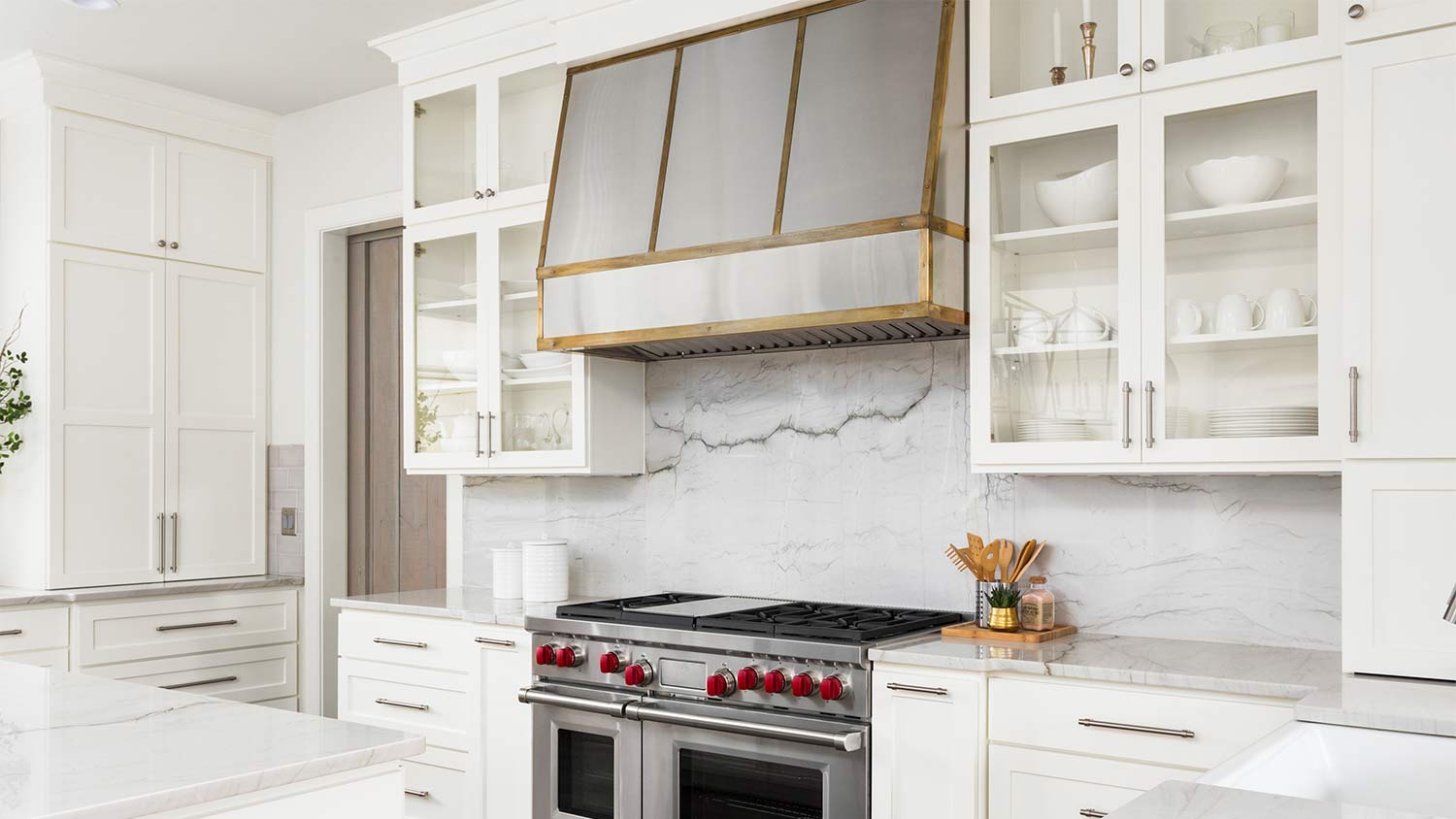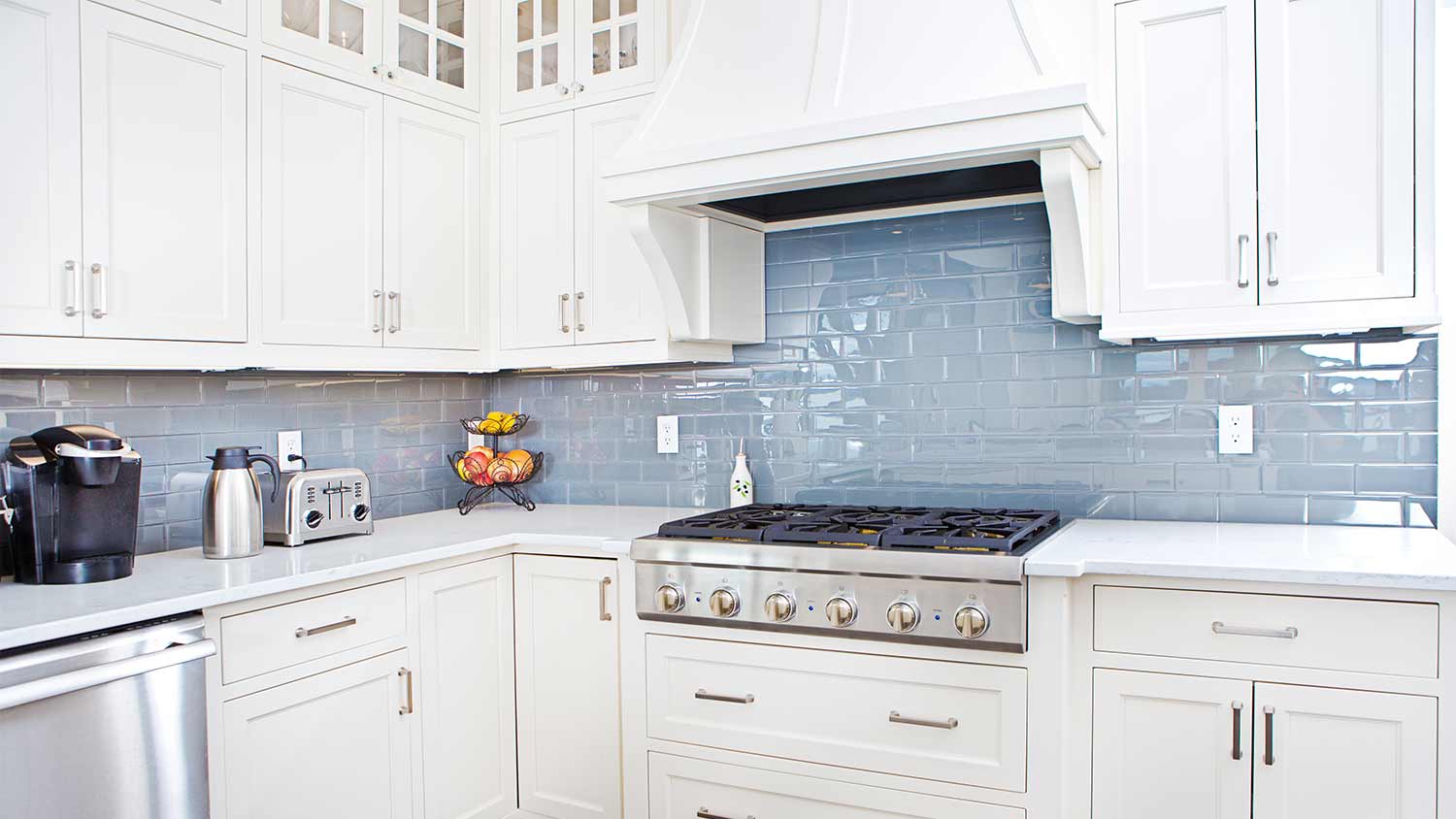
Sink installation costs depend on the type of sink, the material, and the labor. This guide can help you budget for your project—from pedestal to farmhouse.
Today’s a new day—no need to smell last night’s fish fry dinner


Range hoods come in vented, non-vented, and convertible styles.
There are many options where you can install your range hood.
Consider price, design, materials, and more when choosing a range hood.
Your kitchen is the heart of the home—it’s also a prime spot for grease buildup on your cabinets, walls, and ceilings. Luckily, a vented stove can keep your kitchen clean and fresh from smoke, oils, and potent foods. So, while you’re busy planning your next kitchen remodel or refresh, don’t forget to add a range hood to your checklist. Read on to learn the key differences between vented and non-vented range hoods.
We’ve heard that every kitchen needs a range hood, but what exactly is it? Range hoods capture smoke and cooking grease through a fan or filter. Then, it exhausts the contaminated air directly outside through a vent duct or back inside your kitchen if you have a non-vented model. Naturally, a vented stove does a better job of eliminating polluted air and all of the grease, grime, and smoke that goes along with it—making your daily kitchen cleaning much easier.
Vented and non-vented range hoods help keep your kitchen fresh by removing contaminated air. The key differences between the two are in the name: the vented models connect to a vent duct, and the non-vented models are ductless, which means they do not filter the air to the outside.
Vented stoves suck all the grimy air out of your kitchen, filter the air through a duct, and expel it outside. Vented range hoods are typically larger than ductless models and cost more. In addition, range hood installations are challenging—so it’s a good idea to hire a range hood installer near you for this project.
On the flip side, non-vented range hoods are not connected to ducts. Instead, a non-vented range hood captures air through a charcoal filter and exhausts clean air back into your kitchen. While still effective at trapping grease, smoke, and odors, non-ducted range hoods are no match to the performance of vented stoves. Yet, non-vented range hoods are perfect for small kitchens or condos that can’t vent a hood to the outside.
In addition to vented and non-vented range hoods, convertible range hoods are also available—these come in vented and non-vented styles, often containing conversion kits.

Range hoods come in all shapes, sizes, colors, and price points. The most common range hoods are wall-mounted, down-draft, under-cabinet, island, and microwave. Below we’ll discuss the features of each type:
The wall-mounted range hood probably comes to mind when you think of a vented stove. Wall-mounted range hoods are the most common type of vent—they are affixed to the wall directly over your stove in place of a cabinet. Wall-mounted range hoods are usually available in ducted and ductless styles.
You’ll find down-draft ventilation systems next to or behind a stovetop. They work by sucking polluted air into a floor duct and filtering it outside. Down-draft systems offer a clean, flush look because they can pop up when needed—otherwise, they can remain hidden. This system's downside is that it is less effective than overhead range hoods.
You’ll typically mount under-cabinet range hoods to the bottom of a kitchen cabinet that sits directly over your stove. Under-cabinet range hoods usually extend halfway across the stove so they can easily capture steam, smoke, and grease and direct them away from the cabinet above. Most under-cabinet range hoods are available in vented and non-vented styles.
Island ceiling range hoods mount to the ceiling above a detached kitchen island or a peninsula—an attached extension of your kitchen cabinets. These range hoods are typically large and encompass the entire cooktop, making it easy to suck up and discard fumes. Because they are so visual, you can add decorative lights and other features to give some oomph to your kitchen. And you can usually choose between vented and non-vented models.
Microwave range hoods are often installed underneath a cabinet and placed directly over the stove. They have a carbon filter and recirculate air either outside via a duct or back inside as recirculated air. Microwave ovens are great space savers. In terms of affordability, over-the-range microwaves are typically the most wallet-friendly.

While vented range hoods offer great air circulation and style, they may not be great for smaller spaces.
Superior at capturing air, smoke, grease, oils, steam, and humidity
Reduces odors in the kitchen and house
Provides better air circulation and flow in the kitchen
Equipped with strong filters
Lots of choices for decorative elements
More expensive to install
You might lose a spot for a microwave
It might be too large for your space
It can be limiting if a duct can only go in certain areas of your kitchen

Non-vented range hoods offer great space-saving capabilities for condo buildings or smaller kitchens, but they aren’t as effective as sucking up polluted air as vented ranges.
Versatility—you can choose where to put it
Ease of installation
Perfect for a limited renovation budget
Doesn’t circulate air as efficiently
Does not remove humidity from your kitchen
Requires more fan power—which can be louder than vented models
Filters need regular cleaning or replacing

When choosing a vented or non-vented range hood, there are several factors to consider, including price, installation cost, size, design, noise level, materials, and more.
Non-vented models: Average $100–$300
Vented models: Average $100–$1,000
Convertible: Average $200–$1,000
The typical cost to install a range hood runs between $400 and $1,500, with an average price of $750. The installation cost will vary depending on the type of range hood, materials, labor, and exhaust style.
In addition, if your kitchen already doesn’t have a duct, you’ll need to hire the right ductwork contractor for the job. You can expect to pay an average of $85 per hour to install ductwork—on top of the $350 to route your duct outside or $260 to route your duct through the roof.
When choosing the perfect range for your kitchen remodel, you’ll need to make sure you choose one that covers the entire area of your stove so it’s powerful enough to capture all of the smoke and oils. Purchase a range hood that's as wide as your cooktop and deep enough to cover at least half of the front and all back burners.
Range hood design can truly make or break a kitchen’s aesthetic. In addition to offering stylish attributes, many range hoods feature LED lighting, variable fan speeds, dishwasher-safe filters, touch-panel details, and automatic shut-off. Shop around, and choose one that fits your look and lifestyle.
Not all range hoods are created equal, and the power of your range hood will depend on its cubic feet of air moved per minute (CFM) requirements. Essentially, CFM measures how long it takes for captured air to pass through the range hood. For example, gas stoves heat up your kitchen more than electric stoves, so you’ll want to choose a higher CFM range hood for gas cooktops. Look for range hoods with a high CFM number, but with quiet operational features, so you don't have a large, noisy range hood.
Higher-priced materials will cost you more than standard materials, such as stainless steel, for your range hood. For example, copper-finished range hoods run between $250 and $12,500, and a glass range hood can cost up to $1,500.
It’s safe to say that the range hood is your kitchen's star performer. So, yes, you need a range hood! Range hoods clean the air in your kitchen and capture grease and oils that can stain your cabinets, walls, and ceilings.
If you like to cook regularly and whip up foods with odors like fish or steak, you’ll want to invest in a range hood. We also recommend range hoods for gas, electric, and induction stoves—these all produce smoke, grease, and heat.
Finally, some municipalities require range hood installations in the kitchen. So it’s a good idea to check your local building codes before purchasing a range hood.
From average costs to expert advice, get all the answers you need to get your job done.

Sink installation costs depend on the type of sink, the material, and the labor. This guide can help you budget for your project—from pedestal to farmhouse.

An in-law suite can add value to your home and provide space for additional family members. Use this guide to get an idea of how much it will cost to build an in-law suite.

The cost to demo a bathroom depends on its size, complexity, extent of the demo, and whether you DIY or not. This guide will help you budget effectively.

Ready for a bathroom refresh? If you’re considering a new tub, learn the pros and cons of some of the best bathtub materials on the market.

Knowing how to install a shower requires some skill and experience, but a shower enclosure installation is a doable DIY project if you follow some basic steps.

Mirror, mirror, on the wall—how do I hang you so you won’t fall? Get tips and tricks for how to hang a vanity mirror and keep your reflection straight.